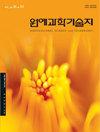温室环境因子对夏栽培甜椒产量的影响及影响因素
IF 1
4区 农林科学
Q3 HORTICULTURE
Korean Journal of Horticultural Science & Technology
Pub Date : 2023-04-30
DOI:10.7235/hort.20230019
引用次数: 0
摘要
本研究旨在分析夏季温室环境因子对甜椒(Capsicum annuum L.)产量的影响,确定影响因素。2021年对江原道2个甜椒出口农场(仁济FIn和铁原FCh)进行了调查。甜椒三月开始开花。FIn采用双茎培养35周,FCh采用三茎培养31周。从第一花期开始,太阳累积辐射量逐渐增加,在7月达到峰值,之后由于8月降雨频繁,太阳累积辐射量下降到60%左右。7月气温较高,白天气温超过30℃,夜间气温超过21℃。从7月4日到8月13日,夜间气温高达26°C。生长特性分析表明,与FCh相比,FIn的花长较短,茎粗较细,节间较短。1组FIn的相对节间率为138%,显著高于FCh。但从第2组开始,这一比例低于第4组,显著低于第4组,达到80%。FIn和FCh的下半年产量分别占总产量的36.1%和39.9%。两个农场在第5组的结实率都很低,在第4组和第5组的收获率也很低。注意到,第4组和第5组的低坐果率和收获率导致下半年的低产量。多元回归分析结果表明,白天温度和太阳辐射水平与产量水平呈正相关,夜间温度和生长日数(GDD)(24小时平均温度- 10)呈负相关。影响较大的顺序如下:夜间温度、太阳辐射、GDD和白天温度。根据研究结果,建议在7月份温度较高的时候,通过降低夜间温度,尽量减少太阳辐射的减少,将24小时平均温度控制在最佳范围内,以保证夏季甜椒下半年的产量。本文章由计算机程序翻译,如有差异,请以英文原文为准。
Effects of Greenhouse Environmental Factors on the Productivity of Summer-cultivated Sweet Pepper and Influential Factors
This study was conducted to analyze the effects of summer greenhouse environmental factors on the productivity of sweet pepper (Capsicum annuum L.) and to determine the influential factors. Two sweet pepper export farms in Gangwon-do (FIn in Inje and FCh in Cheorwon) were surveyed during 2021. The flowering of sweet pepper started in March. FIn undertook two-stemmed cultivation for 35 weeks and FCh utilized three-stemmed cultivation for 31 weeks. The amount of accumulated solar radiation gradually increased from the first flowering period, peaking in July, after which it decreased to about 60% due to frequent rainfall in August. The temperature was high in July, with the day temperature exceeding 30°C and the night temperature being over 21°C. The night temperature increased to as high as 26°C from July 4 to August 13. An analysis of the growth characteristics showed that FIn has a shorter flower length, a thinner stem diameter, and a shorter internode compared to FCh. The relative internode ratio of FIn was 138% for group 1, which is significantly higher than that of FCh. However, the ratio became lower than that of FCh from group 2 and significantly shorter for group 4, reaching 80%. The second half productions of FIn and FCh were 36.1 and 39.9% of the total production rates, respectively. Both farms showed sharply low fruit-set rates in group 5 along with very low harvest rates in groups 4 and 5. It was noted that the low fruit-set rate and harvest rates for groups 4 and 5 led to low yields in the second half of the year. Multiple regression analysis results showed that daytime temperatures and solar radiation levels were positively linked to production levels, while night-time temperatures and growing degree days (GDD) (24h-mean temperature minus 10) were negatively linked. Greater influences were observed in the following order: night-time temperature, solar radiation, GDD, and daytime temperature. Based on the obtained results, it is recommended to keep the 24h-mean temperature in the optimal range by keeping night-time temperatures lower while minimizing the decrease in solar radiation in July when the temperature is high in order to secure production in the second half of the year for summer-cultivated sweet pepper.
求助全文
通过发布文献求助,成功后即可免费获取论文全文。
去求助
来源期刊
CiteScore
2.00
自引率
0.00%
发文量
0
审稿时长
1 months
期刊介绍:
Horticultural Science and Technology (abbr. Hortic. Sci. Technol., herein ‘HST’; ISSN, 1226-8763), one of the two official journals of the Korean Society for Horticultural Science (KSHS), was launched in 1998 to provides scientific and professional publication on technology and sciences of horticultural area. As an international journal, HST is published in English and Korean, bimonthly on the last day of even number months, and indexed in ‘SCIE’, ‘SCOPUS’ and ‘CABI’. The HST is devoted for the publication of technical and academic papers and review articles on such arears as cultivation physiology, protected horticulture, postharvest technology, genetics and breeding, tissue culture and biotechnology, and other related to vegetables, fruit, ornamental, and herbal plants.

 求助内容:
求助内容: 应助结果提醒方式:
应助结果提醒方式:


